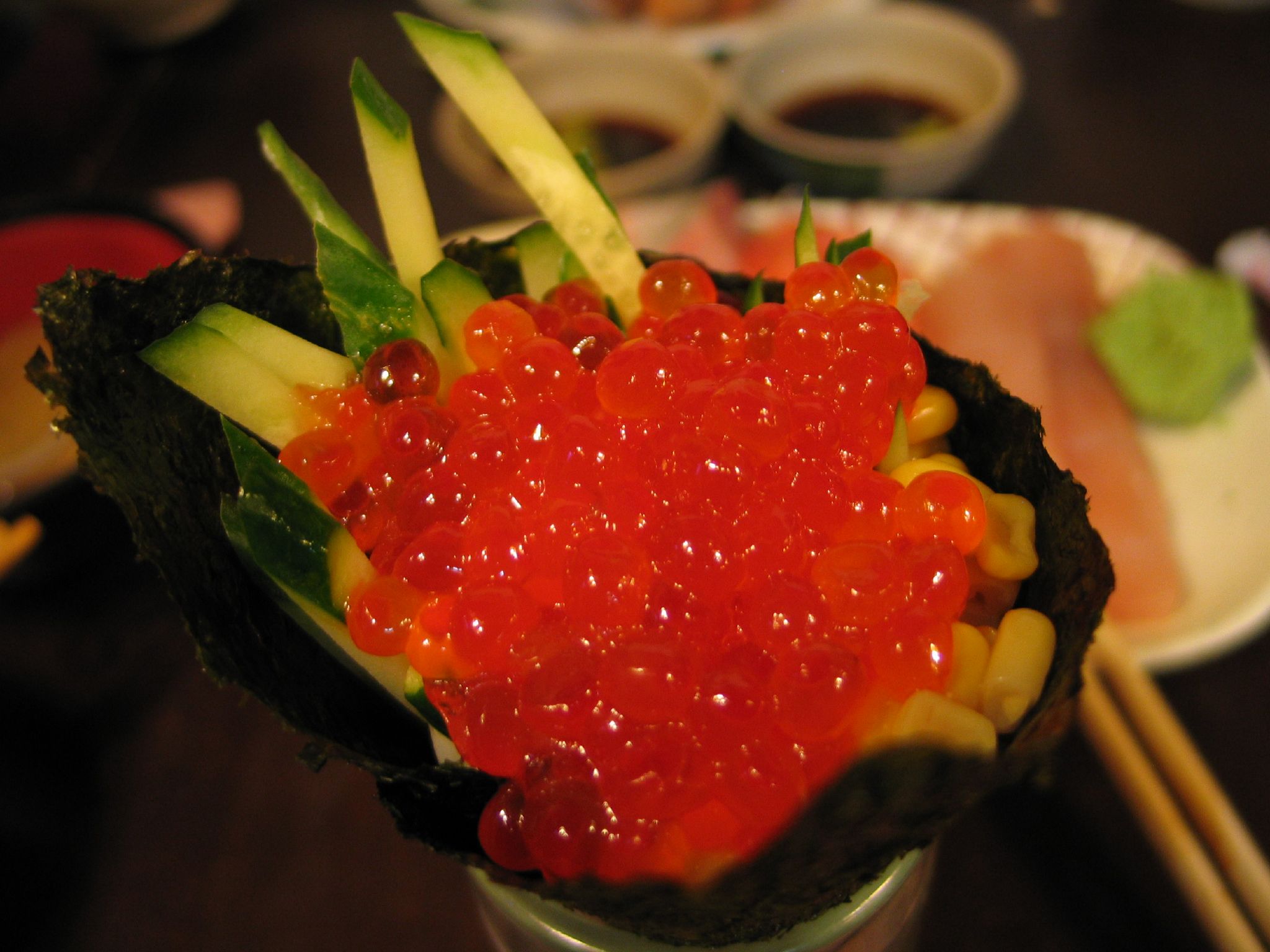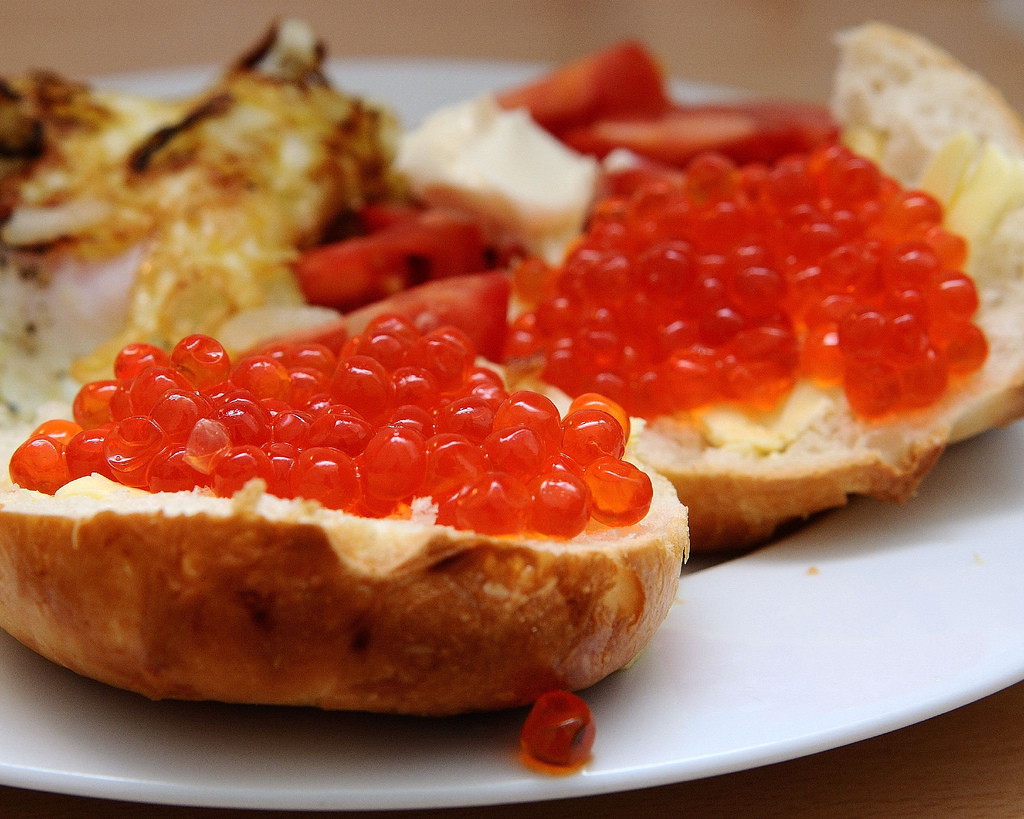ikura on:
[Wikipedia]
[Google]
[Amazon]

 Red caviar is a
Red caviar is a

 Red caviar is a
Red caviar is a caviar
Caviar or caviare is a food consisting of salt-cured roe of the family Acipenseridae. Caviar is considered a delicacy and is eaten as a garnish or spread. Traditionally, the term caviar refers only to roe from wild sturgeon in the Caspi ...
made from the roe
Roe, ( ) or hard roe, is the fully ripe internal egg masses in the ovaries, or the released external egg masses, of fish and certain marine animals such as shrimp, scallop, sea urchins and squid. As a seafood, roe is used both as a cooking, c ...
of salmonid
Salmonidae (, ) is a family of ray-finned fish, the only extant member of the suborder Salmonoidei, consisting of 11 extant genera and over 200 species collectively known as "salmonids" or "salmonoids". The family includes salmon (both Atlantic a ...
fishes (various species of salmon
Salmon (; : salmon) are any of several list of commercially important fish species, commercially important species of euryhaline ray-finned fish from the genera ''Salmo'' and ''Oncorhynchus'' of the family (biology), family Salmonidae, native ...
and trout
Trout (: trout) is a generic common name for numerous species of carnivorous freshwater ray-finned fishes belonging to the genera '' Oncorhynchus'', ''Salmo'' and ''Salvelinus'', all of which are members of the subfamily Salmoninae in the ...
), which has an intense reddish hue. It is distinct from black caviar, which is made from the roe of sturgeon
Sturgeon (from Old English ultimately from Proto-Indo-European language, Proto-Indo-European *''str̥(Hx)yón''-) is the common name for the 27 species of fish belonging to the family Acipenseridae. The earliest sturgeon fossils date to the ...
.Nichola Fletcher, ''Caviar: A Global History'' (Reaktion Books
Reaktion Books is an independent book publisher based in Islington, London, England. It was founded in 1985 in Edinburgh, Scotland, and moved to London in 1987. Reaktion originally focused on the fields of art, architecture, and design. In recen ...
, 2010), p. 90–91.
Although commonly referred to as caviar, red caviar is not considered "true caviar" under the traditional definition, which restricts the term to salted roe from sturgeon species (family Acipenseridae). In culinary and regulatory contexts, particularly in Europe, red caviar is classified as fish roe or caviar substitute. In North America, however, the term “caviar” may legally be used for non-sturgeon roe, provided the species name (e.g. "salmon caviar") is included on the label.
Red caviar is part of Russian
Russian(s) may refer to:
*Russians (), an ethnic group of the East Slavic peoples, primarily living in Russia and neighboring countries
*A citizen of Russia
*Russian language, the most widely spoken of the Slavic languages
*''The Russians'', a b ...
and Japanese cuisine
Japanese cuisine encompasses the regional and traditional foods of Japan, which have developed through centuries of political, economic, and social changes. The traditional cuisine of Japan (Japanese language, Japanese: ) is based on rice with m ...
. In Japan
Japan is an island country in East Asia. Located in the Pacific Ocean off the northeast coast of the Asia, Asian mainland, it is bordered on the west by the Sea of Japan and extends from the Sea of Okhotsk in the north to the East China Sea ...
, salmon caviar is known as () which derives from the Russian
Russian(s) may refer to:
*Russians (), an ethnic group of the East Slavic peoples, primarily living in Russia and neighboring countries
*A citizen of Russia
*Russian language, the most widely spoken of the Slavic languages
*''The Russians'', a b ...
word () which means caviar or fish roe in general.
In Japanese cuisine, it is usually marinated in salt or soy sauce
Soy sauce (sometimes called soya sauce in British English) is a liquid condiment of China, Chinese origin, traditionally made from a fermentation (food), fermented paste of soybeans, roasted cereal, grain, brine, and ''Aspergillus oryzae'' or ''A ...
and sake
Sake, , or saki, also referred to as Japanese rice wine, is an alcoholic beverage of Japanese origin made by fermenting rice that has been polished to remove the bran. Despite the name ''Japanese rice wine'', sake, and indeed any East Asi ...
. The seasoning used varies between households. Many families pickle red caviar using only soy sauce, but some use dashi
is a family of stocks used in Japanese cuisine. ''Dashi'' forms the base for miso soup, clear broth soup, noodle broth soup, and many simmering liquids to accentuate the savory flavor known as umami. ''Dashi'' is also mixed into the flour b ...
instead of sake or mirin
is a type of rice wine and a common ingredient in Japanese cuisine, Japanese cooking. It is similar to sake but with a lower alcohol (drug), alcohol content and higher sugar content. The sugar content is a complex carbohydrate that forms natur ...
.
Russians
Russians ( ) are an East Slavs, East Slavic ethnic group native to Eastern Europe. Their mother tongue is Russian language, Russian, the most spoken Slavic languages, Slavic language. The majority of Russians adhere to Eastern Orthodox Church ...
enjoy red caviar appetizers (''zakuski
''Zakuski'' (, ; ) is the term for an assortment of cold hors d'oeuvres, entrées and snacks in Russian food culture. They are considered to be an integral part of any Russian festive meal, as well as often everyday meals.
Terminology
Ori ...
'') on buttered bread or on a blini
Blini (plural ''blinis'' or ''blini'', rarely ''bliny''; pl., Ukrainian: млинці pl., ''mlyntsi''), singular: blin, are an Eastern European crêpe made from various kinds of flour of buckwheat, wheat, etc. They may be served with smeta ...
( Slavic crêpes). Caviar on blini may be paired with sliced salmon and champagne, especially on such occasions as Russian New Year's Eve.
References